BY JANET STEINBERG
This is not an April Fool’s joke. It may be
tongue-in-cheek, but it’s true.
tongue-in-cheek, but it’s true.
On April 23,1982, Key West, Florida seceded from the United
States of America and formed The Conch Republic. Their motto, and
the Conch Republic flag, reads: “We Seceded Where Others Failed”.
States of America and formed The Conch Republic. Their motto, and
the Conch Republic flag, reads: “We Seceded Where Others Failed”.
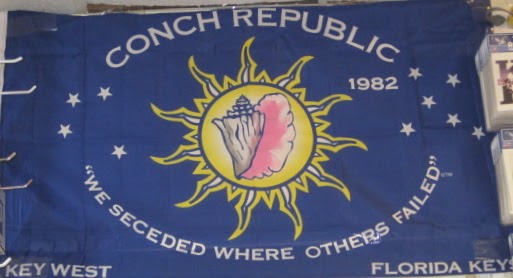 |
| SYMBOLIC FLAG OF KEY WEST |
The trouble began when the United States Border Patrol set
up a roadblock and inspection point on highway US 1 at the place where the
highway connected the Florida Keys to the Mainland. Vehicles were stopped and searched for
narcotics and illegal immigrants, thus creating traffic delays and hassles for
tourists.
up a roadblock and inspection point on highway US 1 at the place where the
highway connected the Florida Keys to the Mainland. Vehicles were stopped and searched for
narcotics and illegal immigrants, thus creating traffic delays and hassles for
tourists.
The complaints of the Conchs (Key Westerners’
nickname…pronounced konks) went
unanswered, so the City Council took matters into their own hands. They protested saying that since they were
being treated as a foreign country, they might as well be one. They took the name of the Conch Republic and
declared war against the United States.
nickname…pronounced konks) went
unanswered, so the City Council took matters into their own hands. They protested saying that since they were
being treated as a foreign country, they might as well be one. They took the name of the Conch Republic and
declared war against the United States.
 |
| LOCAL CONCHS IN JUNKANOO BAND |
The April 23 war lasted one minute as the city’s Mayor (who
was proclaimed Prime Minister) symbolically broke a loaf of stale Cuban
bread over the head of a man dressed in a naval uniform. The Prime Minister then surrendered and
applied for one billion dollars in foreign aid.
was proclaimed Prime Minister) symbolically broke a loaf of stale Cuban
bread over the head of a man dressed in a naval uniform. The Prime Minister then surrendered and
applied for one billion dollars in foreign aid.
Key West did not get the billion dollars in foreign
aid, but they did get a billion dollars worth of publicity.
aid, but they did get a billion dollars worth of publicity.
Cayo Hueso, or “The Island of Bones”, as the 18th century
Spaniards called Key West, is located 155 miles south of Miami. The Overseas Highway, sometimes called the
“Highway that Goes to Sea”, is 113 miles of roadway (including the Seven-mile
Bridge at Marathon) that leapfrogs the Florida Keys to their most southerly
point.
Spaniards called Key West, is located 155 miles south of Miami. The Overseas Highway, sometimes called the
“Highway that Goes to Sea”, is 113 miles of roadway (including the Seven-mile
Bridge at Marathon) that leapfrogs the Florida Keys to their most southerly
point.
Today, century-old forts and gingerbread mansions remain as
a tribute to the colorful heritage of what was once Florida’s largest, and
America’s richest, city. The best way
to see the city in a short time is by riding the Old Town Trolley and the Conch
Tour Train.
a tribute to the colorful heritage of what was once Florida’s largest, and
America’s richest, city. The best way
to see the city in a short time is by riding the Old Town Trolley and the Conch
Tour Train.
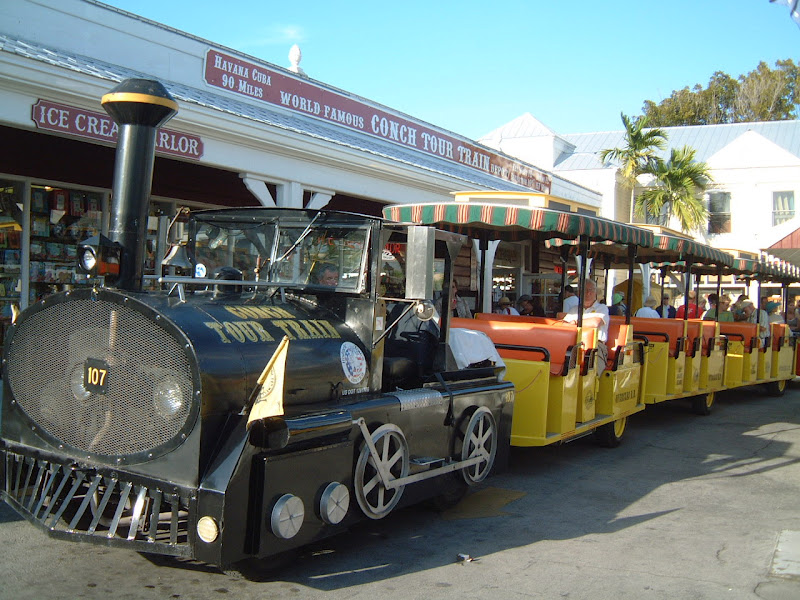 |
| CONCH TOUR TRAIN |
Palm-studded streets shade the pastel retreats that once
housed such notables as Ernest Hemingway, Tennessee Williams and John
Audubon. “Papa” Hemingway, the first
important writer to discover and make Key West his home, arrived there in 1928
when he was working on “A Farewell to Arms”.
It was in Key West that he also penned most of his great novels including
“For Whom the Bell Tolls”, “To Have and Have Not” and “The Macomber Affair”.
housed such notables as Ernest Hemingway, Tennessee Williams and John
Audubon. “Papa” Hemingway, the first
important writer to discover and make Key West his home, arrived there in 1928
when he was working on “A Farewell to Arms”.
It was in Key West that he also penned most of his great novels including
“For Whom the Bell Tolls”, “To Have and Have Not” and “The Macomber Affair”.
Today, visitors can tour the National Historic Landmark
that was the home of Pulitzer Prize winner Ernest Hemingway. Several items of the property are of
particular note. A replica of the
ceramic cat sculpture, given to the cat-loving
“Papa” Hemingway by his friend Picasso, sits atop a chest.
that was the home of Pulitzer Prize winner Ernest Hemingway. Several items of the property are of
particular note. A replica of the
ceramic cat sculpture, given to the cat-loving
“Papa” Hemingway by his friend Picasso, sits atop a chest.
 |
| HEMINGWAY HOUSE |
A discarded Sloppy Joe’s urinal, given to Hemingway by his
good friend Joe Russell (owner of Hemingway’s hang-out joint “Sloppy Joes”), was
turned into what must be the most famous feline watering hole in the world. An old Spanish olive jar forms the top of the
fountain. The trough that forms the base
of the fountain is the above-mentioned urinal. Hemingway’s then-wife Pauline
surrounded the trough with colorful tiles in an attempt to disguise its true
identity.
good friend Joe Russell (owner of Hemingway’s hang-out joint “Sloppy Joes”), was
turned into what must be the most famous feline watering hole in the world. An old Spanish olive jar forms the top of the
fountain. The trough that forms the base
of the fountain is the above-mentioned urinal. Hemingway’s then-wife Pauline
surrounded the trough with colorful tiles in an attempt to disguise its true
identity.
Also noteworthy is a penny embedded in the poolside
patio. Having paid $20,000 for the first
swimming pool built in Key West (in the late 1930’s), Hemingway took a penny
from his pocket, pressed it into the wet cement of the surrounding patio. Hemingway then told his wife: “Well, you
might as well take my last cent.” The
wife, Hemingway’s second of four, was ultimately divorced. The poolside penny remains.
patio. Having paid $20,000 for the first
swimming pool built in Key West (in the late 1930’s), Hemingway took a penny
from his pocket, pressed it into the wet cement of the surrounding patio. Hemingway then told his wife: “Well, you
might as well take my last cent.” The
wife, Hemingway’s second of four, was ultimately divorced. The poolside penny remains.
A living memorial to the late author has also been
preserved at his Spanish-colonial mansion.
Approximately 40-50 polydactyl (six-toed) cats, descendants of the nearly
50 cats who lived there with “Papa”, still call 907 Whitehead Street
home.
preserved at his Spanish-colonial mansion.
Approximately 40-50 polydactyl (six-toed) cats, descendants of the nearly
50 cats who lived there with “Papa”, still call 907 Whitehead Street
home.
Harry Truman’s Little White House, which initially served
as the command headquarters during the Spanish American War, first served as
President Truman’s winter White House in 1946. Today, the Harry S. Truman Little
White House is a fascinating public museum as well as a retreat and place of
government business by our nation’s leaders.
as the command headquarters during the Spanish American War, first served as
President Truman’s winter White House in 1946. Today, the Harry S. Truman Little
White House is a fascinating public museum as well as a retreat and place of
government business by our nation’s leaders.
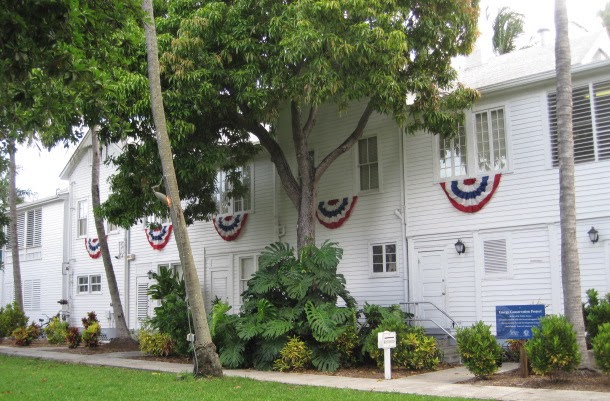 |
| PRESIDENT HARRY S. TRUMAN’S LITTLE WHITE HOUSE |
Another major attractions in Key West is the Mel Fisher
Treasure Museum where you can view the Mother Lode from the treasure-laden
Spanish galleon Atocha.
Treasure Museum where you can view the Mother Lode from the treasure-laden
Spanish galleon Atocha.
The picturesque 21-acre, 1847 Key West Cemetery, in the
“dead” center of the island’s historic district, is a photographic gem filled
with humor and history. Carved into the
headstone of a widow’s deceased philandering husband is this message: “At least
I know where he’s sleeping tonight.”
“dead” center of the island’s historic district, is a photographic gem filled
with humor and history. Carved into the
headstone of a widow’s deceased philandering husband is this message: “At least
I know where he’s sleeping tonight.”
As you walk along Seventh Avenue, a black archway with the
letters “B’nai Zion” marks the entry to the Jewish Cemetery. To the immediate
left is a large white crypt with a facing tablet expounding another expression
of Conch humor. It reads: “I told you I
was sick.”
letters “B’nai Zion” marks the entry to the Jewish Cemetery. To the immediate
left is a large white crypt with a facing tablet expounding another expression
of Conch humor. It reads: “I told you I
was sick.”
Two
photo ops are not to be missed in Key West.
The Southernmost Point in the continental United States, only 90 miles
from Cuba, is marked by a large, red concrete buoy at the corner of South and Whitehead Streets.
photo ops are not to be missed in Key West.
The Southernmost Point in the continental United States, only 90 miles
from Cuba, is marked by a large, red concrete buoy at the corner of South and Whitehead Streets.
 |
| SOUTHERNMOST POINT CONCRETE BUOY |
The
small green Mile Marker 0 sign, at the junction of Fleming and Whitehead
Streets, marks the southern tip of U.S. Highway 1.
small green Mile Marker 0 sign, at the junction of Fleming and Whitehead
Streets, marks the southern tip of U.S. Highway 1.
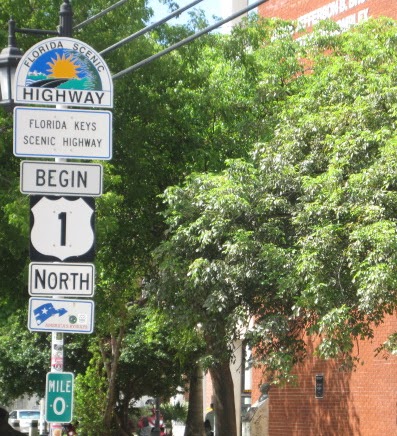 |
| MILE MARKER 0 (ZERO) |
Accommodations range from the many charming B&Bs throughout
the city, to the Pier House Resort and the Westin Resort & Marina in the
heart of Old Town, to the luxurious, historic 1920s Casa Marina at Higgs Beach.
the city, to the Pier House Resort and the Westin Resort & Marina in the
heart of Old Town, to the luxurious, historic 1920s Casa Marina at Higgs Beach.
You really haven’t been to Key West until you’ve downed a
few at Captain Tony’s and Sloppy Joe’s.
When Hemingway first came to Key West, he frequented a rough and tumble
fisherman’s saloon at 428 Greene Street.
This became the original Sloppy Joe’s Bar, “Papa’s” favorite haunt.
few at Captain Tony’s and Sloppy Joe’s.
When Hemingway first came to Key West, he frequented a rough and tumble
fisherman’s saloon at 428 Greene Street.
This became the original Sloppy Joe’s Bar, “Papa’s” favorite haunt.
When Sloppy’s rent was raised, owner Joe Russell instructed
his patrons to pick up their drinks and bar stools, and they all moved to its
present location at 201 Duval Street.
The Greene Street saloon then became known as Captain
Tony’s.
his patrons to pick up their drinks and bar stools, and they all moved to its
present location at 201 Duval Street.
The Greene Street saloon then became known as Captain
Tony’s.
Call them colorful…call them honky-tonk…or call them
tourist traps. Call them whatever you
like. But, by any other name, Captain
Tony’s and Sloppy Joe’s are much more than mere saloons. They are symbolic
personifications of Key West itself.
tourist traps. Call them whatever you
like. But, by any other name, Captain
Tony’s and Sloppy Joe’s are much more than mere saloons. They are symbolic
personifications of Key West itself.
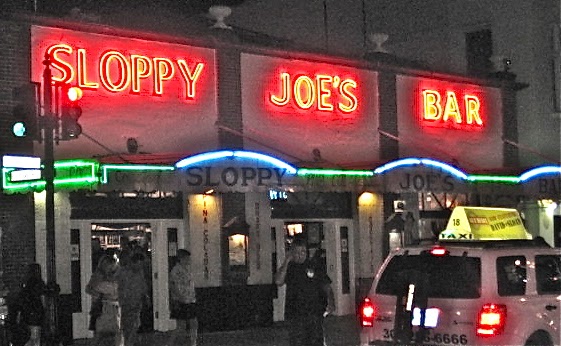 |
| SLOPPY JOE’S BAR |
Whether it’s Conch-Caribbean, Cuban, Chinese, or Classical
American food you prefer, you can find them all—and more—in Key West.
American food you prefer, you can find them all—and more—in Key West.
Of course, there’s always a cheeseburger at Jimmy Buffet’s
Margaritaville. If you don’t mind eating
in an unpainted funky shack, there’s B.O.’s Fish Wagon for a fresh fish sandwich
served on fresh-baked Cuban bread. A hand-painted sign states: “if it looks like
fish, and smells like fish, it ain’t fresh”.
You’ll either “get this place”, or you won’t!
Margaritaville. If you don’t mind eating
in an unpainted funky shack, there’s B.O.’s Fish Wagon for a fresh fish sandwich
served on fresh-baked Cuban bread. A hand-painted sign states: “if it looks like
fish, and smells like fish, it ain’t fresh”.
You’ll either “get this place”, or you won’t!
However for a lovely dining experience, SHOR American
Seafood Grill serves the best of the area’s fresh-off-the-boat seafood in a
million-dollar setting with a drop-dead view of the Gulf of Mexico and the
glorious Key West sunset. A short ferry ride from the Westin Hotel will sail you to Sunset Key where an equally glorious sunset is an extra bonus that comes with a divine dinner at Latitudes.
Seafood Grill serves the best of the area’s fresh-off-the-boat seafood in a
million-dollar setting with a drop-dead view of the Gulf of Mexico and the
glorious Key West sunset. A short ferry ride from the Westin Hotel will sail you to Sunset Key where an equally glorious sunset is an extra bonus that comes with a divine dinner at Latitudes.
Yes, the sun sets.
It happens every night.
It happens everywhere in the world.
But, in Key West, Florida, it is much more than something that just
happens. It is a
happening.
It happens everywhere in the world.
But, in Key West, Florida, it is much more than something that just
happens. It is a
happening.
 |
| KEY WEST SUNSET |
Sunset at continental America’s southernmost city–that
flaming moment when the great orange ball seems to drop off the edge of the
universe–is a fiery celebration. It is
the sun, the green-blue waters of the Gulf of Mexico, and the people. It is the local Conch, the visitor, the
juggler, the belly dancer, and the mime…all of whom gather at Mallory Square
Pier for nature’s nightly spectacular.
flaming moment when the great orange ball seems to drop off the edge of the
universe–is a fiery celebration. It is
the sun, the green-blue waters of the Gulf of Mexico, and the people. It is the local Conch, the visitor, the
juggler, the belly dancer, and the mime…all of whom gather at Mallory Square
Pier for nature’s nightly spectacular.
This island of contrasts is a place where pirates once
preyed and presidents once played. It is
a place where straight meets gay, where drunk drinks with sober. It is Caribbean and continental, traditional
and avant garde. It is the Conch people, conch fritters, conch
chowder, the Conch Tour Train, Conch High School, and Conch cheerleaders known
as Conchettes, just to name a few. By
the time you leave this end of the Florida Keys, this end of the highway, and
this end of the rainbow, I can assure you, you’ll be conch-ed out.
preyed and presidents once played. It is
a place where straight meets gay, where drunk drinks with sober. It is Caribbean and continental, traditional
and avant garde. It is the Conch people, conch fritters, conch
chowder, the Conch Tour Train, Conch High School, and Conch cheerleaders known
as Conchettes, just to name a few. By
the time you leave this end of the Florida Keys, this end of the highway, and
this end of the rainbow, I can assure you, you’ll be conch-ed out.
JANET STEINBERG is the winner of 38 national Travel Writer
Awards and an International Travel Consultant with The Travel Authority in
Mariemont, Ohio.
Awards and an International Travel Consultant with The Travel Authority in
Mariemont, Ohio.
